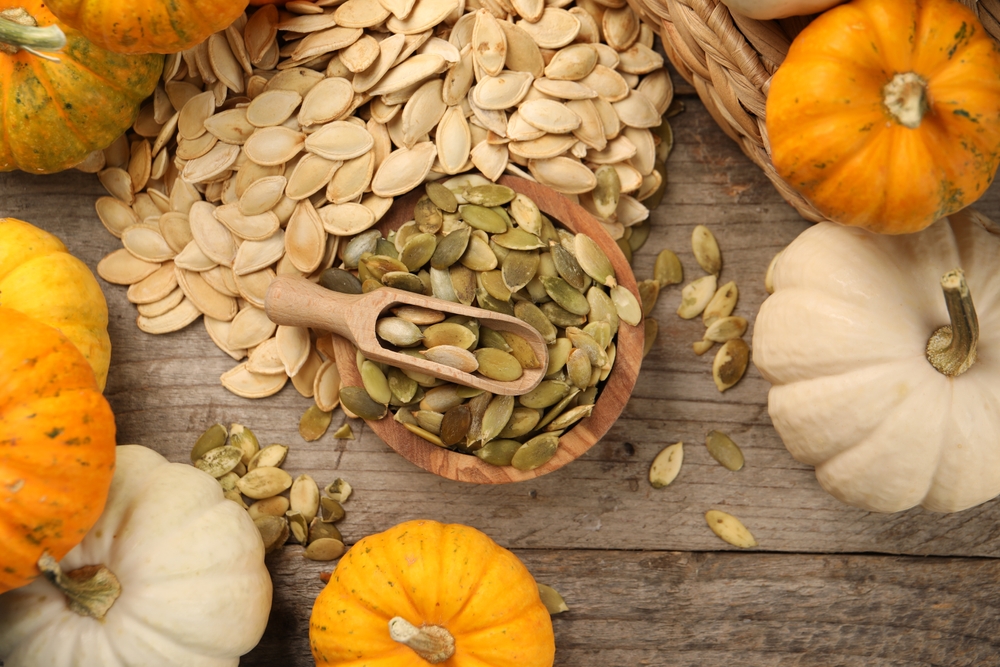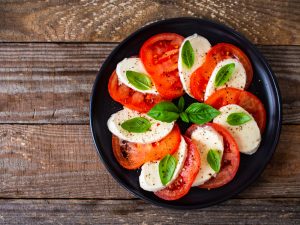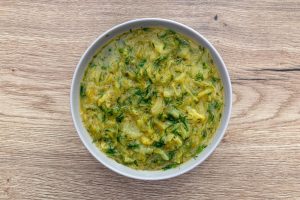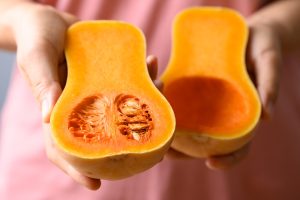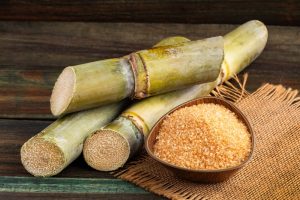Yes, pumpkin seeds can support weight loss thanks to their high protein, fiber, and healthy fat content, which help control hunger and stabilize energy.
Keep reading for a detailed look at how to use them effectively—without accidentally overdoing it.
What Makes Pumpkin Seeds a Strong Weight Loss Snack
Pumpkin seeds aren’t just a crunchy topping or seasonal novelty—they’re a nutrient-dense food that actually earns its spot in a weight loss plan.
Their specific mix of protein, fiber, and slow-burning energy makes them especially useful for managing appetite and staying on track between meals.
High Protein and Fiber = Longer Fullness, Fewer Cravings
One of the main reasons pumpkin seeds support weight loss is their protein and fiber content.
Just half a cup of shelled pumpkin seeds (pepitas) delivers around 21 grams of protein and 5 grams of fiber, while the same amount of unshelled seeds provides roughly 7 grams of protein and 1.5 grams of fiber.
These two nutrients work together in a very practical way:
- Protein takes longer to break down during digestion, helping you feel full longer and reducing the chances of reaching for snacks soon after a meal.
- Fiber slows the movement of food through your digestive tract and triggers satiety signals in the gut. That means fewer cravings and less impulse snacking throughout the day.
By combining both, pumpkin seeds create a slow, steady release of energy instead of a sharp spike and crash.
This matters because energy crashes often lead to reaching for quick, high-calorie foods—something a steady-burning snack like pumpkin seeds can help you avoid.
A Snack That Works Harder Than Most
Compared to more common snack options like crackers, chips, or even granola bars, pumpkin seeds pull more weight nutritionally.
Many processed snacks are heavy on refined carbs and light on protein and fiber—meaning they digest quickly, spike your blood sugar, and leave you hungry again soon after.
Pumpkin seeds do the opposite.
Even just a small serving—about one ounce or 28 grams—offers roughly 8.5 grams of protein, moderate fiber, and enough healthy fat to help you stay full between meals.
That makes them especially effective for those looking to limit overall calorie intake without feeling deprived.
Healthy Fats and Micronutrients: Small Seeds, Big Impact
Pumpkin seeds may be small, but they’re loaded with nutrients that do more than just fill you up—they actively support the systems in your body that regulate fat storage, energy use, and appetite.
This isn’t just about general nutrition; it’s about how these specific compounds play targeted roles in weight management.
Unsaturated Fats That Work With Your Body
Unlike saturated fats that can be harder for the body to process efficiently, pumpkin seeds are rich in unsaturated fats—mainly oleic acid and linoleic acid.
These fats are known to:
- Support fat metabolism, helping your body break down and use fat more effectively for energy rather than storing it.
- Enhance satiety signaling, so your brain registers when you’ve had enough to eat—something that's critical when you're trying to stay within a calorie range without feeling constantly hungry.
These fats also help keep blood sugar more stable and reduce insulin spikes, both of which can influence how your body stores fat over time.
Magnesium: A Metabolism Ally
Magnesium often flies under the radar, but it plays a direct role in how your body converts food into energy.
Pumpkin seeds are one of the richest plant-based sources of magnesium, and that matters because:
- Magnesium helps regulate glucose metabolism, making sure sugar from food is processed efficiently instead of being stored as fat.
- It supports muscle function and recovery, which becomes especially important if your weight loss plan includes exercise.
- Magnesium deficiencies are common and can lead to fatigue, cravings, and sluggish metabolism—barriers you want to avoid when trying to lose weight.
Including pumpkin seeds in your meals can help fill that gap in a way that’s easy and sustainable.
Zinc: Quietly Managing Hunger and Inflammation
Zinc, another key mineral found in pumpkin seeds, helps regulate several hormonal and immune functions tied to weight control. It contributes to:
- Appetite regulation through its influence on hormones like leptin and ghrelin (which tell your brain when you're hungry or full).
- Inflammatory balance, keeping systemic inflammation in check. Chronic inflammation can interfere with metabolism and promote fat storage, especially around the abdomen.
While zinc’s effects aren’t always felt directly, having enough in your diet makes it easier for your body to function the way it’s supposed to—without working against your weight loss goals.
Why This Nutrient Mix Matters for Weight Loss
It’s easy to think of protein and calorie counts as the only numbers that matter for weight loss.
But if your metabolism is inefficient, your appetite cues are off, or inflammation is quietly building in the background, even a low-calorie diet can feel like an uphill battle.
Pumpkin seeds bring in nutrients that support these behind-the-scenes systems—making your efforts more effective and sustainable.
Inflammation and Blood Sugar: The Hidden Barriers to Fat Loss
Even with a solid diet and regular exercise, hidden factors like inflammation and unstable blood sugar can quietly stall your progress.
Pumpkin seeds bring nutrients that specifically help calm these disruptions—creating a more supportive internal environment for fat loss to actually happen.
The Anti-Inflammatory Nutrients You May Be Overlooking
Pumpkin seeds contain a range of compounds that help reduce chronic inflammation, including polyphenols, magnesium, zinc, and selenium.
While these nutrients are often talked about for immune or heart health, they also play key roles in regulating body composition.
Chronic inflammation—especially low-grade, persistent inflammation—can interfere with your body’s ability to respond to insulin.
That means more circulating glucose, more fat storage, and less effective energy use.
It also disrupts hormones tied to hunger and satiety, making it harder to stay in control of what and how much you eat.
By bringing down inflammation, these nutrients support better insulin sensitivity and more efficient metabolic signaling—two pieces many people overlook when trying to lose weight.
Blood Sugar Stability = Fewer Cravings and More Energy
Fluctuating blood sugar is one of the fastest ways to derail a weight loss plan.
Sharp rises and drops can trigger intense cravings, especially for sugar and carbs, and lead to energy crashes that leave you reaching for whatever’s most convenient.
Pumpkin seeds can help keep those swings in check.
Their combination of protein, fiber, healthy fats, and magnesium helps slow the absorption of glucose into your bloodstream, promoting more even energy levels throughout the day.
Plus, magnesium directly improves glucose uptake by your cells, making it easier for your body to use blood sugar efficiently without overproducing insulin.
In fact, a controlled study found that a 65-gram serving of pumpkin seeds reduced blood sugar levels—a promising sign that their impact goes beyond theory and into measurable results.
While 65 grams is more than most people would eat in one sitting, the takeaway is clear: even smaller, regular portions can make a real difference in your daily blood sugar control.
Don’t Overdo It: Calorie Density and Other Caveats
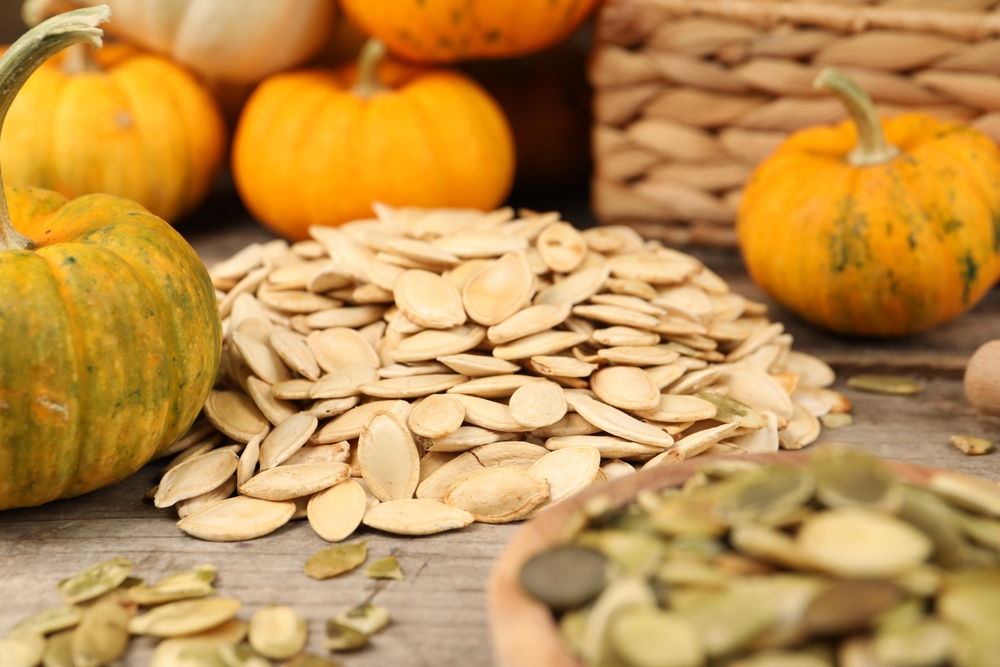
Pumpkin seeds have plenty going for them when it comes to weight loss, but like many nutrient-dense foods, they come with a few important caveats.
Knowing where the benefits end and the risks of overdoing it begin can make the difference between a smart snack and a sneaky source of weight gain.
Calorie Density: Small Serving, Big Impact
One of the biggest things to watch with pumpkin seeds is their high calorie and fat content.
Just ½ cup of shelled seeds contains around 415 calories and 35 grams of fat.
That’s a lot of energy in a relatively small amount of food. In contrast, ½ cup of unshelled seeds only has about 130 calories because the shell takes up space and slows down consumption.
This means portion control isn't optional—it’s essential.
Even though the fats are healthy, eating too many pumpkin seeds can easily push you into a calorie surplus, which directly works against your weight loss goals.
A handful can help with hunger control; several handfuls eaten mindlessly can do the opposite.
To stay within a supportive range:
- Aim for around 1 ounce (28 grams) per serving—about a small handful—which delivers a balanced mix of protein, fat, and fiber at roughly 150–160 calories.
- If you’re tracking your intake, measure the seeds occasionally until you can eyeball the right amount consistently.
Phytic Acid: The Absorption Trade-Off
Pumpkin seeds also contain phytic acid, a natural compound found in many seeds and legumes.
While it isn’t harmful in small amounts, it can bind to minerals like zinc, iron, and calcium—reducing your body’s ability to absorb them efficiently.
This doesn’t mean you need to avoid pumpkin seeds, but it does suggest preparation matters.
Soaking or sprouting the seeds before eating them can help reduce phytic acid levels.
Light roasting can also minimize it, although it may also reduce some heat-sensitive nutrients like certain polyphenols or omega-3s.
If you're relying on pumpkin seeds as a regular snack, especially in a plant-based diet where mineral absorption matters even more, choosing soaked or sprouted seeds occasionally can offer a helpful nutritional edge.
High Fiber = Great (Until It’s Too Much)
The fiber in pumpkin seeds is a plus—but in high amounts, especially from unshelled seeds, it can cause bloating or digestive discomfort.
The shells are tough and fibrous, and for people not used to that much roughage, it can overwhelm the gut quickly.
If you’re new to eating pumpkin seeds or you notice discomfort:
- Start with smaller portions and see how your body reacts.
- Opt for shelled seeds (pepitas) if digestion is a concern—they’re easier on the stomach and still provide a good nutrient profile.
- If you prefer unshelled for the extra fiber or crunch, chew thoroughly and consider spacing your portions out through the day.
How to Use Pumpkin Seeds for Weight Loss the Right Way
Pumpkin seeds can absolutely fit into a weight loss plan—but how you eat them makes all the difference.
The form, portion size, timing, and preparation method all influence whether they support your progress or quietly slow it down.
Portion Size: Small Amount, Big Benefit
For weight management, 1 ounce (about 28 grams) is the sweet spot.
That’s roughly a small handful or around 2 tablespoons of shelled seeds, and it contains about 150–160 calories and 8.5 grams of protein.
This portion is enough to curb hunger, support muscle recovery, and stabilize energy—without tipping your daily calorie balance in the wrong direction.
Even healthy foods can become a problem if you consistently go overboard, and seeds are easy to eat mindlessly.
Pre-portioning them into small containers or buying single-serve packs can help you stay within a helpful range.
Picking the Right Type: Raw, Soaked, or Roasted?
Not all pumpkin seeds are the same, and what you choose depends on your health priorities and taste preferences.
- Raw seeds (often labeled as pepitas) retain the most nutrients, including heat-sensitive ones like some antioxidants and omega-3s. They’re great for mixing into meals but may feel a bit soft on their own.
- Soaked or sprouted seeds are easier to digest and lower in phytic acid, which helps your body absorb more of the minerals like zinc and magnesium. They also tend to be gentler on the stomach, making them a better choice if you’re new to eating seeds regularly or have a sensitive gut.
- Roasted seeds are crunchier and have a longer shelf life, which makes them more convenient for snacking. However, roasting at high temperatures can reduce some of their nutritional value. Stick to lightly roasted options when possible.
As for flavoring: unsalted or lightly salted seeds are best.
Excess sodium from heavily salted versions can lead to water retention and may increase cravings for more salty foods—both of which can work against your weight goals.
When to Eat Them: Timing Matters
Pumpkin seeds can work as a strategic snack or as a booster to meals—timing them right can help you stay in control of your appetite.
- Mid-morning or afternoon: A small portion between meals can keep your energy stable and reduce the chances of reaching for processed snacks out of convenience.
- Post-workout: Thanks to their protein and healthy fats, pumpkin seeds make a good recovery snack when paired with a small piece of fruit or a shake, helping manage hunger until your next meal.
Avoid eating them late at night or directly from the bag while distracted, as that’s when portion sizes tend to creep up without you realizing it.
Add to Meals for Extra Texture and Satiety
One of the easiest ways to get the benefits of pumpkin seeds without overeating them is to sprinkle small amounts into meals.
They not only improve nutrient density but also add texture and help make your food more satisfying.
Try adding:
- A tablespoon to oatmeal or overnight oats in the morning
- A sprinkle on salads for crunch and extra protein
- A few into yogurt bowls alongside fruit and a touch of honey
- Blended into smoothies for a thicker, more filling consistency
This approach integrates the seeds into your eating routine without making them the focus, which helps you keep portions in check.
Soaked vs. Roasted: Nutritional and Digestive Considerations
If your goal is to maximize digestion and mineral absorption, soaked seeds are your best bet.
They’re easier on the gut and retain more delicate nutrients, making them ideal for anyone focused on nutrient efficiency or gut health.
Roasted seeds, on the other hand, shine in terms of convenience and taste.
If you’re more likely to consistently eat pumpkin seeds because you enjoy the flavor and crunch of roasted ones, that may outweigh the small nutrient trade-offs—especially if the rest of your diet is balanced.
The key is to pick a form you’ll actually use regularly and enjoy, while still keeping the nutritional details in mind.
Sample Day: Realistic Ways to Add Pumpkin Seeds Without Overeating
You don’t need a huge amount of pumpkin seeds to get their benefits.
Spreading small, measured portions through the day gives you steady protein, fiber, and minerals without racking up calories—or falling into the “healthy snack” trap that leads to overeating.
Breakfast: Oatmeal Upgrade With Raw Pepitas
Stir 1 tablespoon (about 10 g) of raw pepitas into hot oatmeal or overnight oats.
The seeds add texture, a bit of protein, and minerals like magnesium and zinc without a large calorie load.
Because the portion is small, you get flavor and staying power while keeping breakfast macro-friendly.
If you like toppings, mix the seeds in rather than piling them on top; that helps you keep the amount controlled.
Mid-Morning Snack: 1 oz + Fruit for Blood Sugar Control
When that late-morning dip hits, go with about 1 oz (28 g) of pumpkin seeds—roughly a small handful or a pre-portioned snack bag—and pair them with fruit such as an apple, pear slices, or berries.
The seeds bring protein, healthy fats, and fiber; the fruit adds natural carbs and water content.
Together they slow the blood sugar rise you’d get from fruit alone and help hold you until lunch.
Pre-portioning is key here. If you pour from a large bag, it’s easy to double the serving without noticing.
Post-Workout: Light Handful to Bridge the Gap
After training, many people get hungrier than expected and overeat at the next meal.
A light handful of pumpkin seeds—on their own, or mixed into yogurt or a shake—can take the edge off that rebound hunger.
You get protein to support muscle repair and fats that extend satiety until you can sit down for a balanced meal.
Keep the portion modest; this is a bridge snack, not a second lunch.
Why Spacing Out Portions Works
Instead of eating a large serving in one sitting, dividing smaller amounts through the day helps smooth energy levels and appetite signals.
Each touchpoint—breakfast mix-in, controlled snack, post-workout top-up—keeps you from hitting the kind of hunger spikes that lead to oversized meals later.
Smaller, spaced servings also make total daily calories easier to manage, because you’re building structure into when and how much you eat.
Adjusting for Your Diet and Activity Level
Your ideal daily amount isn’t fixed. If you’re highly active, training hard, or running a calorie deficit that leaves you hungry, you might include two measured seed servings in a day (for example, breakfast + snack).
On lighter activity days, stick to one serving and get variety from other foods like vegetables, lean proteins, or legumes.
If you follow a higher-fat eating pattern (such as low-carb), pumpkin seeds can replace part of a nut portion; if you’re targeting lower fat, use the smaller breakfast add-in and skip the extra snack.
Track your overall intake for a few days so you see how these small servings add up across the week.
Putting the Sample Day Together
- Breakfast: Oatmeal with 1 tbsp (≈10 g) raw pepitas mixed in.
- Mid-Morning Snack: 1 oz (28 g) pumpkin seeds + a piece of fruit.
- Post-Workout: Light handful of seeds (or mix into yogurt) to manage hunger before your next meal.
Follow that pattern and you’ll get the appetite control and metabolic support pumpkin seeds offer—without sliding into calorie creep.
Conclusion
Pumpkin seeds can support weight loss when used intentionally—not just because they’re healthy, but because they help manage hunger, energy, and metabolism.
The key is moderation, smart timing, and choosing the right form.
With small, consistent portions, they can quietly strengthen your results without adding unnecessary calories.

